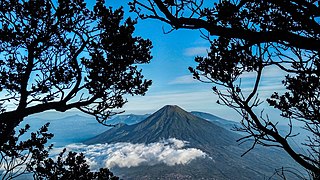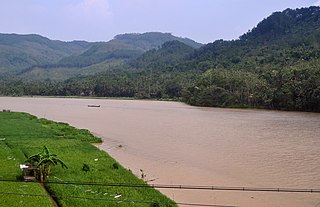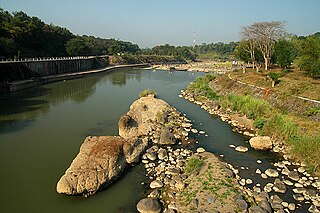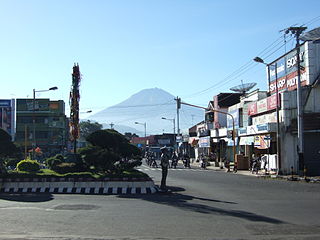
The Indonesian island of Java is almost entirely of volcanic origin, and contains numerous volcanoes, 45 of which are considered active volcanoes. As is the case for many other Indonesian islands, volcanoes have played a vital role in the geological and human history of Java. Indeed, land is created on Java as a result of lava flows, ash deposits, and mud flows (lahars). Volcanoes are a major contributor to the immense fertility of Java, as natural erosion transports volcanic material as alluvium to the island's plains, forming thick layers of fertile sediment. The benefit is not just in the immediate vicinity of the volcano, with fine ash emitted from eruptions being dispersed over wide areas.

Magelang is one of six cities in Central Java that are administratively independent of the regencies in which they lie geographically. Each of these cities is governed by a mayor rather than a bupati. Magelang city covers an area of 18.54 km2 and has a population of 118,227 at the 2010 census and 121,526 at the 2020 census; the official estimate as at mid 2022 was 121,675. It is located in the middle of the Magelang Regency, between Mount Merbabu and Mount Sumbing in Central Java Province, Indonesia, and lies 43 km north of Yogyakarta, 15 km north of Mungkid and 75 km south of Semarang, the capital of Central Java.

Kedu Plain, also known as Progo River valley, is the fertile volcanic plain that lies between the volcanoes Mount Sumbing and Mount Sundoro to the west, and Mount Merbabu and Mount Merapi to the east. It roughly corresponds to present-day Magelang and Temanggung Regency of Central Java, Indonesia.

Mount Salak is an eroded volcano in West Java, Indonesia. It has several satellite cones on its southeast flank and the northern foot, along with two additional craters at the summit. Mount Salak has been evaluated for geothermal power development. According to a popular belief, the name "Salak" is derived from salak, a tropical fruit with scaly skin; however, according to Sundanese tradition, the name was derived from the Sanskrit word Salaka which means "silver". Mount Salak can be translated to "Silver Mountain" or "Mount Silver".

Mount Sindoro, Mount Sindara or Mount Sundoro is an active stratovolcano in Central Java, Indonesia. Parasitic craters and cones are found in the northwest-southern flanks; the largest is called Kembang. A small lava dome occupies the volcano's summit. Historical eruptions have been mostly mild to moderate.

Temanggung Regency is an inland regency in the Central Java Province of Indonesia. It covers a land area of 870.65 km2 and had a population of 708,546 at the 2010 Census and 790,174 at the 2020 Census; the official estimate as at mid 2022 was 799,764, comprising 402,114 males and 397,650 females. Its capital is the town of Temanggung.

Mount Pangrango is a dormant stratovolcano located in the Sunda Arc of West Java, Indonesia. The mountain formed by a subduction zone on the southern coast of Java as part of the Sunda Plate facing the Australian Plate which contains Indian Ocean. It is located about 80 kilometres (50 mi) south of Jakarta, the capital of Indonesia.

Opak River is a river in central south area of Java island, Indonesia.

Borobudur Temple Compounds is the World Heritage designation of the area of three Buddhist temples in Central Java, Indonesia. It comprises Borobudur, Mendut, and Pawon. The temples were built during the Shailendra dynasty around the 8th and 9th centuries CE and fall on a straight line.
The Mantyasih inscription is an important inscription found and kept by Li Djok Ban in Ngadireja Parakan Temanggung, then the inscription was brought by one of the princes of Surakarta to be brought to Surakarta and is now stored in the Radyapustaka Museum, Central Java, Indonesia. It is dated to 907 and was created by King Balitung from the Sanjaya dynasty, of the Ancient Mataram Kingdom. This inscription contains a genealogy of the kings of Mataram before King Balitung.

The Bodri River is a river in Kendal Regency, northern Central Java, Indonesia. The Bodri River flows from the south to north into Java Sea.

The Serayu River is a river in Central Java, Indonesia, about 300 km southeast of the capital Jakarta.

The Progo River is a river in southern central Java, Indonesia. The river passes through two provinces; Central Java and Yogyakarta Special Region. The source of the river is on the slopes of Mount Sindoro, Central Java.
The Comal River is a river in Jawa Tengah, Indonesia. It rises in the North Serayu Mountains from Mount Slamet. The river has a length of around 109.18 km flowing from south to north, ending in Java Sea. It is the largest river in Pemalang Regency, Central Java, and flows through seven districts within that regency.

Moung Andong is a mountain in Magelang Regency, Central Java in Indonesia. Andong mountain is located between Ngablak and Tlogorjo, Grabag and has an altitude of around 1,463 meters. Andong Mountain is one of several mountains that encircle Magelang, adjacent to Mount Telomoyo. The mountain is on the border of the Salatiga, Semarang and Magelang regions.

Wonosobo is a small town in Wonosobo Regency Central Java, Indonesia. Wonosobo lies between mountains, Mount Sundoro and Mount Sumbing. The name its self derived from Sanskrit Vanasabha, which means "gathering place in the forest".

The Western Java montane rain forests ecoregion covers the montane rain forest above 1,000 meters in the volcanic mountain ridges in the west of the island of Java in Indonesia. Several mammals and bird species are found only in this ecoregion, including the Javan mastiff bat (Otomops formosus) and the Volcano mouse (Mus vulcani). Only about one-fifth of the original rainforest remains in its original state, as human pressures are encroaching on the mountain slopes.




















